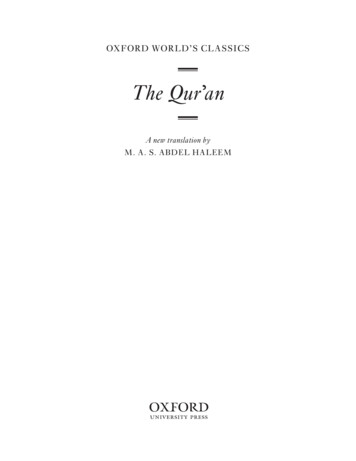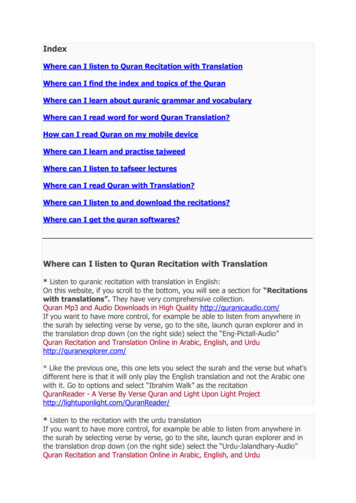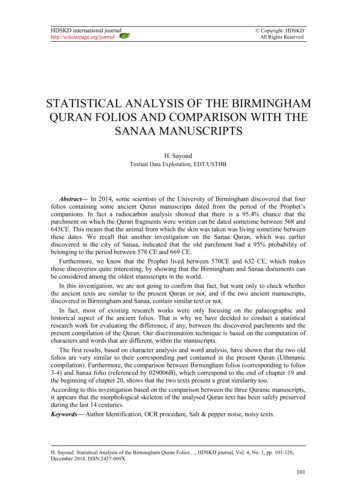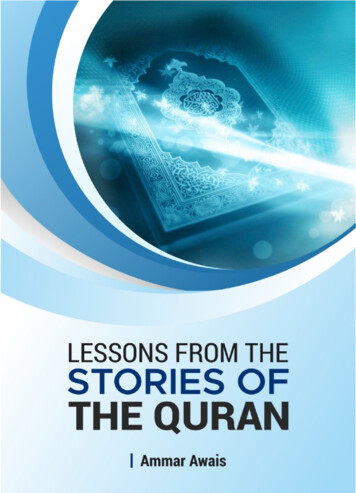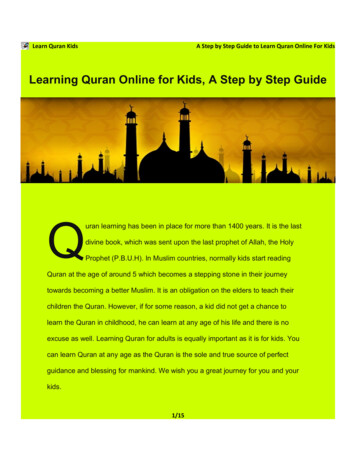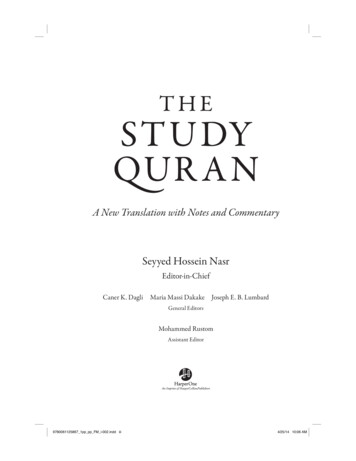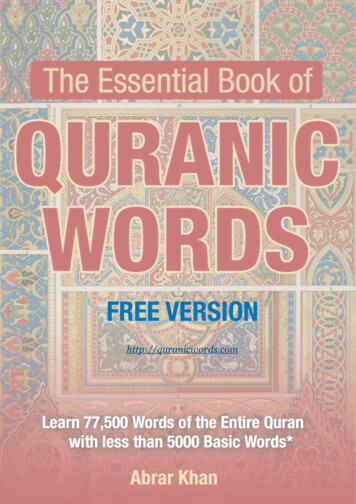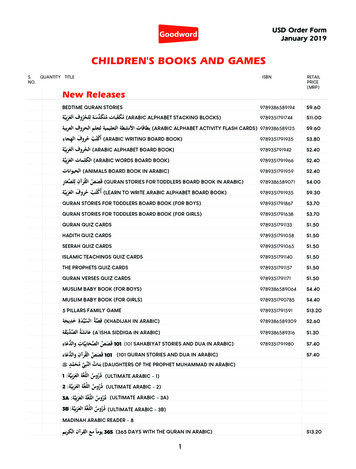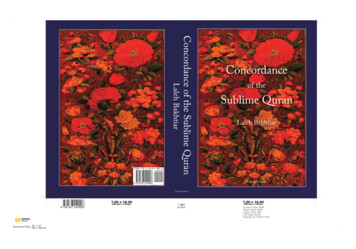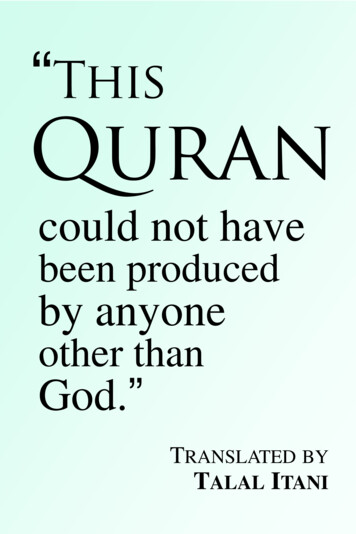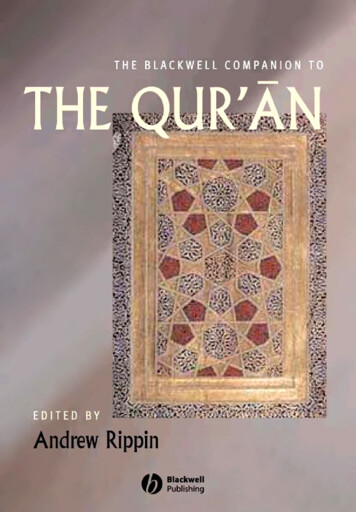
Transcription
The Blackwell Companionto the Qur ān
Blackwell Companions to ReligionThe Blackwell Companions to Religion series presents a collection of the most recent scholarshipand knowledge about world religions. Each volume draws together newly-commissioned essaysby distinguished authors in the field, and is presented in a style which is accessible to undergraduate students, as well as scholars and the interested general reader. These volumes approachthe subject in a creative and forward-thinking style, providing a forum in which leading scholars in the field can make their views and research available to a wider audience.PublishedThe Blackwell Companion to JudaismEdited by Jacob Neusner and Alan J. Avery-PeckThe Blackwell Companion to Sociology of ReligionEdited by Richard K. FennThe Blackwell Companion to the Hebrew BibleEdited by Leo G. PerdueThe Blackwell Companion to Postmodern TheologyEdited by Graham WardThe Blackwell Companion to HinduismEdited by Gavin FloodThe Blackwell Companion to Political TheologyEdited by Peter Scott and William T. CavanaughThe Blackwell Companion to ProtestantismEdited by Alister E. McGrath and Darren C. MarksThe Blackwell Companion to Modern TheologyEdited by Gareth JonesThe Blackwell Companion to Christian EthicsEdited by Stanley Hauerwas and Samuel WellsThe Blackwell Companion to Religious EthicsEdited by William SchweikerThe Blackwell Companion to Christian SpiritualityEdited by Arthur HolderThe Blackwell Companion to the Study of ReligionEdited by Robert A. SegalThe Blackwell Companion to the Qur ānEdited by Andrew RippinThe Blackwell Companion to Contemporary Islamic ThoughtEdited by Ibrahim M. Abu-Rabi ForthcomingThe Blackwell Companion to the Bible and CultureEdited by John SawyerThe Blackwell Companion to Eastern ChristianityEdited by Ken ParryThe Blackwell Companion to the New TestamentEdited by David AuneThe Blackwell Companion to CatholicismEdited by James J. Buckley
The Blackwell Companionto the Qur ānEdited byAndrew Rippin
2006 by Blackwell Publishing Ltdexcept for editorial material and organization 2006 by Andrew RippinBLACKWELL PUBLISHING350 Main Street, Malden, MA 02148-5020, USA9600 Garsington Road, Oxford OX4 2DQ, UK550 Swanston Street, Carlton, Victoria 3053, AustraliaThe right of Andrew Rippin to be identified as the Author of the Editorial Material in this Workhas been asserted in accordance with the UK Copyright, Designs, and Patents Act 1988.All rights reserved. No part of this publication may be reproduced, stored in a retrieval system,or transmitted, in any form or by any means, electronic, mechanical, photocopying, recordingor otherwise, except as permitted by the UK Copyright, Designs, and Patents Act 1988,without the prior permission of the publisher.First published 2006 by Blackwell Publishing Ltd1 2006Library of Congress Cataloging-in-Publication DataThe Blackwell companion to the Qur ān / edited by Andrew Rippin.p. cm.—(Blackwell companions to religion)Includes bibliographical references and index.ISBN-13: 978-1-4051-1752-4 (hardcover : alk. paper)ISBN-10: 1-4051-1752-4 (hardcover : alk. paper)1. Koran—Critism, interpretation, etc. 2. Koran—Appreciation.I. Rippin, Andrew, 1950– . II. Title: Companion to the Qur ān. III. Series.BP130.4.B57 2006297.1′226—dc22200524135A catalogue record for this title is available from the British Library.Set in 10 on 12.5 pt Photinaby SNP Best-set Typesetter Ltd, Hong KongPrinted and bound in Singaporeby C.O.S. Printers Pte LtdThe publisher’s policy is to use permanent paper from mills that operate a sustainable forestrypolicy, and which has been manufactured from pulp processed using acid-free and elementarychlorine-free practices. Furthermore, the publisher ensures that the text paper and cover boardused have met acceptable environmental accreditation standards.For further information onBlackwell Publishing, visit our website:www.blackwellpublishing.com
ContentsList of ContributorsviiiPrefaceAndrew RippinxPart I Orientation11 IntroducingTamara Sonn32 DiscoveringChristopher Buck183 ContextualizingAbdullah Saeed36Part II Text514 Linguistic StructureSalwa M. S. El-Awa535 Patterns of AddressRosalind Ward Gwynne736 LanguageMustansir Mir887 Poetry and LanguageNavid Kermani1078 Foreign VocabularyMichael Carter120
viCONTENTS9 Structure and the Emergence of CommunityAngelika Neuwirth14010 Sacrality and CollectionAliza Shnizer15911 Written TransmissionFrançois Déroche17212 Context: Muh.ammadHerbert Berg18713 Context: Umar b. al-Khat.t.ābAvraham Hakim205Part III Content22114 GodAndrew Rippin22315 Prophets and ProphethoodUri Rubin23416 MosesBrannon Wheeler24817 ArgumentationKate Zebiri26618 Knowing and ThinkingA. H. Mathias Zahniser28219 Sex, Sexuality, and the FamilyKhaleel Mohammed29820 JihādReuven Firestone308Part IV Interpretation32121 Hermeneutics: al-Tha labı̄Walid Saleh32322 Stories of the ProphetsMarianna Klar33823 S.ūfismAlan Godlas35024 Rūmı̄Jawid Mojaddedi36225 Twelver Shı̄ ı̄ Ta wı̄lDiana Steigerwald373
CONTENTSvii26 Ismā ı̄lı̄ Ta wı̄lDiana Steigerwald386V Application40127 Exegetical SciencesJane Dammen McAuliffe40328 TheologyBinyamin Abrahamov42029 JurisprudenceA. Kevin Reinhart43430 Contemporary Ethical IssuesLeah Kinberg45031 Narrative LiteratureRoberto Tottoli46732 RecitationAnna M. Gade481Bibliography494Index of People, Places and Topics524Index of Qur ān Verses542
ContributorsBinyamin Abrahamov, Professor of Islamic Theology and Qur ānic Studies, Bar-IlanUniversity, Israel.Herbert Berg, Associate Professor, Department of Philosophy and Religion, University of North Carolina, Wilmington, USA.Christopher Buck, Department of Writing, Rhetoric and American Cultures/Department of Religious Studies/Center for Integrative Studies in the Arts and Humanities,Michigan State University, USA.Michael Carter, Professor of Arabic, University of Oslo (until 2005), HonoraryProfessor at the Centre for Medieval Studies of Sydney University, Australia.François Déroche, Professor, École pratique des hautes études, Paris, France.Salwa M. S. El-Awa, Lecturer in Qur ān and h.adith, Department of Theology and Religion, University of Birmingham, UK.Reuven Firestone, Professor of Medieval Judaism and Islam at Hebrew Union College,Los Angeles, Director, Institute for the Study and Enhancement of Muslim–JewishInterrelations.Anna M. Gade, Assistant Professor, Department of Religion, Oberlin College, Ohio,USA.Alan Godlas, Associate Professor, Department of Religion, University of Georgia, USA.Rosalind Ward Gwynne, Associate Professor of Islamic Studies, Department of Religious Studies, University of Tennessee, USA.Avraham Hakim, Arabic teacher and lecturer on Islam, The Lowy School for Overseas Students, Tel Aviv University, Israel.Navid Kermani, writer, Cologne, Germany.
LIST OF ONTRIBUTORSixLeah Kinberg, Senior Lecturer, Department of Middle Eastern and African History,Tel Aviv University, Israel.Marianna Klar, Research Associate, Centre of Islamic Studies, School of Oriental andAfrican Studies, London, UK.Jane Dammen McAuliffe, Dean of Georgetown College, Professor of History, Professor of Arabic, Georgetown University, Washington DC, USA.Mustansir Mir, University Professor of Islamic Studies, Department of Philosophy andReligious Studies, Youngstown State University, Ohio, USA.Khaleel Mohammed, Assistant Professor of Religion, San Diego State University,California, USA.Jawid Mojaddedi, Assistant Professor, Department of Religion, Rutgers University,New Jersey, USA.Angelika Neuwirth, Professor, Seminar für Semitistik und Arabistik, Freie Universität, Berlin, Germany.A. Kevin Reinhart, Associate Professor, Department of Religion, Dartmouth College,New Hampshire, USA.Andrew Rippin, Dean, Faculty of Humanities, Professor of History, University ofVictoria, Canada.Uri Rubin, Professor, Department of Arabic and Islamic Studies, Tel Aviv University,Israel.Abdullah Saeed, Sultan of Oman Professor of Arab and Islamic Studies, Director ofthe Centre for the Study of Contemporary Islam, University of Melbourne, Australia.Walid Saleh, Assistant Professor, Department of Religion and Department of Near andMiddle Eastern Civilizations, University of Toronto, Canada.Aliza Shnizer, Department of Arabic and Islamic Studies, Tel Aviv University, Israel.Tamara Sonn, Kenan Professor of Religion, Professor of Humanities, College ofWilliam and Mary, Williamsburg, Virginia, USA.Diana Steigerwald, Assistant Professor, Department of Religion, California State University, Long Beach, USA.Roberto Tottoli, Ricercatore, Università degli Studi di Napoli “L’Orientale”, Italy.Brannon Wheeler, Visiting Distinguished Professor of History and Politics, Directorof the Center for Middle East and Islamic Studies, United States Naval Academy,Annapolis, Maryland, USA.A. H. Mathias Zahniser, Professor Emeritus of Religious Studies, Asbury TheologicalSeminary, Wilmore, Kentucky, USA.Kate Zebiri, Senior Lecturer in Arabic and Islamic Studies, School of Oriental andAfrican Studies, London, UK.
PrefaceAndrew RippinThe publication of a volume devoted to the Qur ān in the “companion” genre marksthe emergence of the text of Muslim scripture within the canon of world literature ina manner particularly appropriate to the twenty-first century. This companion is explicitly designed to guide the reader who may have little exposure to the Qur ān beyond acuriosity evoked by the popular media. It aims to provide such a person with the starting point of a general orientation and take him or her to a well-advanced state of understanding regarding the complexities of the text and its associated traditions. However,a “companion” volume such as this is also an opportunity for scholars to extend theboundaries of what might be deemed to be the “accepted” approaches to the text ofthe Qur ān because such a volume provides, it is to be hoped, the material which willinspire future generations of scholars who first encounter the Qur ān in the classroomand for whom new avenues of exploration provide the excitement of research anddiscovery.OrganizationThis companion has been organized in order to facilitate its usefulness for the groupsof readers who may wish to embark on a deeper understanding of the Qur ān in its historical context and as an object of scholarly study. Part I functions as an introductionto the text but its three chapters are oriented in different, yet complementary ways. Allreaders, but especially those who are coming to the Qur ān with little foreknowledge ofthe text and/or the scholarly study of it, will find these chapters the place to start.“Introducing” the Qur ān (chapter 1) means orienting the reader to the basic facts,themselves coming from a variety of perspectives both internal and external to the text.“Discovering” the Qur ān (chapter 2) speaks to the experience of a student and considers how one might integrate the Qur ān within a framework of religious studies.“Contextualizing” the Qur ān (chapter 3) orients the reader to a Muslim scholarly perspective, putting the emphasis on the historical context in which the facts about the
PREFACExiQur ān are to be understood. Each chapter thus adds a level of complexity to the taskof approaching the Qur ān, although each chapter recognizes certain common elements which pose a challenge to the reader, especially the question of the choice of“lens” through which one should read the text.Part II addresses the text of the Qur ān on both the structural and the historical level,two dimensions which have always been seen in scholarly study as fully intertwined.Issues of origin and composition lie deeply embedded in all of these concerns because,it is argued, the structure of the text – which is what makes the book a challenge toread – must be accounted for through the process of history. However, the final aim ofthese attempts at explaining the Qur ān is directed towards a single end, that of comingto an understanding of the text. The internal structure of the Qur ān is the focus ofchapter 4. These observations are complemented by an intricate series of observationsabout the nature of the text and its language, including the patterns of address used inthe text (chapter 5), language – especially its use of literary figures – in chapter 6, therelationship between poetry and language as it affects the Qur ān (chapter 7), and therange of the vocabulary of the text that is thought to come from non-Arabic sourcesin chapter 8. All of these factors – structure, language, and vocabulary – combine andbecome manifested in the emergence of a text of the scripture within the context of acommunity of Muslims (chapter 9), creating the text which emerges as sacred throughthe complex passage of history (chapter 10), which is then transmitted through thegenerations of Muslims, the focus of chapter 11. All of this happens in a historicalcontext of the early community which is shown to be foundational to the understanding of the text in both the person of Muh.ammad and his life (chapter 12) as well asthat of the early leader Umar b. al-Khat.t.āb (chapter 13).Such details provide an understanding of the text on a linguistic and historical levelbut the overall nature of its message is fundamentally ignored in such considerations.Part III thus turns to consider some of the major topics which characterize thatmessage. Muslims have, in fact, seen the Qur ān as all-encompassing in its treatmentof human existence and an inventory of themes can really only provide examples ofways of analyzing and categorizing the contents of the scripture: there is little substitute for a rigorous study of the text itself if one wishes to gain a clear sense of what itis really about as a whole. However, certain aspects do provide key ideas and providethe opportunity to illustrate methods of approach. Dominating all of the messageof the Qur ān is, of course, the figure of Allāh, the all-powerful, one God revealed inthe Qur ān just as He is in the biblical tradition (chapter 14), through a process of revelation brought by prophets (chapter 15), an important one of whom within theMuslim context is Moses (chapter 16), although, of course, figures such as Abrahamand Jesus play a central role in the Qur ān as well. The message those prophets (including Muh.ammad in the Qur ān) bring argues for belief in God (chapter 17) amongreflective, thinking human beings (chapter 18). However, the prophets also bring amessage of how life should be lived in both love (chapter 19) and war (chapter 20).This text of the Qur ān, as all of the preceding material has made clear, is a complexone that Muslims have always known needed interpretation. This might be said tobe the nature of divine revelation which poses the problem of how the infinity andabsoluteness of God can be expressed in the limited and ambiguous format of human
xiiPREFACElanguage. Such a situation calls for a hermeneutics that is elaborated within the framework of Islam (chapter 21) which can also draw its inspiration from a multitude ofsources always filtered through Islamic eyes and needs (chapter 22). Differingapproaches to Islam developed in the Muslim world, variations which the Qur ānfacilitated through its conduciveness to interpretation: thus S.ūfı̄s (chapter 23),Rūmı̄, (chapter 24), Twelver Shı̄ ites (chapter 25) and Ismā ı̄lı̄s (chapter 26) all soughtstrength and support for their ideas in the text of the Qur ān and developed their ownprinciples by which to understand the scripture.However, the Qur ān has far more significance within Muslim life than as an objectfunctioning as a ground for exegesis. The world of the Qur ān extends much further,becoming the basis of scholastic consideration and development of learning within thecontext of exegetical elaboration (chapter 27), theology (chapter 28), and jurisprudence (chapter 29). It is a touchstone for every discussion of ethical issues in themodern world (chapter 30) just as it was the basis for literary development in the classical world (chapter 31). Underlying all of that, however, is the status of the Qur ān notso much as a rational launching pad for further thought but as a text of devotion asdisplayed in the attention to its orality and manifestation in recitation (chapter 32).The application of the Qur ān thus extends through the many aspects of Muslimday-to-day life.Technical ConsiderationsA work such as this depends upon a significant number of scholars interested in makingtheir academic work accessible to a broad reading public and a new generation of students. As editor of the volume, I would like to express my appreciation to all of the contributors – a truly international gathering of scholars – for their efforts. There is adelicate balance in a work such as this between documenting and annotating everythought and being mindful of the variety of readers who are the potential audience;thus, the number of references and endnotes has been drastically reduced but nottotally eliminated, for it is in such supporting apparatus that there lies one of thesources of research directions for future generations of scholars. As well, it is notablethat there clearly continues to be a need to justify many points of discussion with reference to original and secondary sources; it is perhaps indicative of the still-developingnature of Qur ānic studies that it is not possible to assume an agreed-upon core of basicdata and interpretation that would simplify much of the documentation in a volumesuch as this.In an attempt to eliminate some of the “clutter” that is often associated with academic work, the bibliographical references for each chapter have been consolidated intoone overall bibliography at the end of the volume. The exercise of compiling this bibliography has been, for the editor, and for the publisher’s copy-editor as well, a task madeall the more complex because of the lack of standard editions of many works of constant reference in the field – an aspect aggravated by the loose control over the reprinting of works by different publishers in many parts of the Arab world who make noreference to the source of the original print and who often times use slightly variant
PREFACExiiipage numbering even in direct reprints of a text; thus, for some items in the bibliography, several prints will be listed because those are the ones available to individual writersand only seldom has it been possible to consolidate different editions. The situation doesnot exist solely with reprints of Arabic texts in the Arab world, although it certainlyafflicts that area far more extensively; the record of the European publishing project ofthe Encyclopaedia of Islam is equally complex, although the correlations between themultiple versions of that work are at least somewhat more straightforward. For ease ofcitation, all references to the Encyclopaedia of Islam New Edition ( second edition) inthis book have been reduced to EI2 (2004) meaning the CD-ROM version which is adirect reproduction of the printed work in English which appeared in twelve volumes(plus supplements) between 1954 and 2004 (and which is now also available in a Webversion). The now emerging third edition appears to be planned under English headwords, so no correlation with that edition will likely be possible.References to the Qur ān are cited generally in the format “Q sūra number: āyanumber,” numbered according to what is commonly called the Cairo text. Dates aregenerally cited in the format “Hijrı̄/Gregorian” unless otherwise indicated.
The Blackwell Companion to the QuranEdited by Andrew RippinCopyright 2006 by Blackwell Publishing LtdPART IOrientation1IntroducingTamara Sonn32 DiscoveringChristopher Buck18336ContextualizingAbdullah Saeed
CHAPTER 1IntroducingTamara SonnThe Qur ān (“Koran” in archaic spelling) is the sacred scripture of Islam. The termqur ān means “recitation” or “reading,” reflecting the Muslim belief that it is the wordof God, not of the prophet who delivered it. Although the Qur ān was revealed (or “sentdown,” munzal, as the Arabic term has it) in the first/seventh century, Muslims believethat it is nonetheless timeless, the word of God, revealed word for word in the Arabiclanguage through God’s final messenger, Muh.ammad (d. 11/632). Sunnı̄ Muslims(approximately 85 percent of the world’s Muslim population) believe the Qur ān istherefore uncreated; like God, whose speech it is, it has always existed. The Qur ān saysthat its words reflect a divine archetype of revelation, which it calls “the preservedtablet” (al-lawh. al-mah.fūz., Q 85:22). This allows for interpretation of the term qur ān as“reading,” even though Muh.ammad is described by the Qur ān as unlettered or illiterate (Q 7:157; 62:2). Rather than “reading” a message, Muh.ammad is described asdelivering a message that God had imprinted upon his heart (e.g., Q 26:195). At onepoint the Qur ān refers to Gabriel (Jibrı̄l) as the one “who has brought it [revelation]down upon your heart” (Q 2:97). As a result, traditional interpreters claim that Gabrielwas the medium through whom Muh.ammad received God’s revelation.The Qur ān uses the term qur ān seventy times, sometimes generically referring to“recitation” but usually referring to revelation. The Qur ān also refers to itself, as it doesto the Torah and the Gospels, as simply “the book” (al-kitāb), a term used hundreds oftimes to refer to recorded revelation. Muslims therefore frequently refer to the Qur ānas “The Book.” Muslims also commonly use terms such as “noble” (al-Qur ān al-karı̄m),“glorious” (al-Qur ān al-majı̄d), and other terms of respect for the Qur ān. They commemorate annually the beginning of its revelation on the “night of power” (or“destiny,” laylat al-qadr), during the last ten days of Ramad.ān, the month of fasting. Soimportant is the revelation of the Qur ān that the Qur ān describes laylat al-qadr as“better than a thousand months” (Q 97:4).Muslims’ respect for the Qur ān is demonstrated by the fact that only those who arein a state of spiritual purity are allowed to touch it. It is the miracle of Islam;Muh.ammad brought no other. The Qur ān tells us that when people asked Muh.ammad
4TAMARA SONNto demonstrate the authenticity of his prophecy by performing miracles, as otherprophets had done, he offered them the Qur ān. The beauty of its language is believedto be beyond compare, and impossible to imitate. (This belief is conveyed in the doctrineof the inimitability of the Qur ān, i jāz.) Whereas Jesus’ life was miraculous and formsthe basis of Christianity, the Qur ān itself is the basis of Islamic life. It forms the coreof Islamic ritual and practice, learning, and law.Structure of the TextThe Qur ān consists of 114 chapters, called sūras (plural: suwar). The verses of thechapters are called āyāt (singular: āya). The chapters range in length from 7 to 287verses. The first sūra is very short, but the remaining sūras are arranged roughly indescending order of length, that is, from longest to shortest, rather than in chronological order.The chronological order in which the chapters were delivered is determined basedon both internal evidence and traditional literature concerning the circumstances ofrevelation (asbāb al-nuzūl). Although not all scholars agree on the precise dating of allthe verses of the Qur ān, there is general agreement that approximately ninety of thechapters were delivered during the earlier period of revelation, while Muh.ammad andhis community lived in Mecca. The remaining chapters were delivered after the emigration (hijra) to Medina (1/622). Accordingly, scholars often refer to chapters as beingMeccan or Medinan. The former tend to be shorter (and therefore placed at the end ofthe Qur ān), poetic in form, passionate in tone, and characterized by general referencesto monotheism; the glory, power, mercy and justice of God (Allāh, from the Arabic alilāh: the [one] god); and the need for submission (islām) to the will of God in order toachieve the great rewards promised in the afterlife and avoid divine retribution. TheMedinan sūras tend to be longer (and therefore found at the beginning of the Qur ān),more prosaic in form, and deal with more practical issues such as marriage andinheritance.Each chapter of the Qur ān has a name, such as “Opening” (Q 1), “Women” (Q 4),and “Repentance” (Q 9). These names were ascribed after the Qur ān was canonized(established in its authoritative form) and typically derive from major references in thechapters. All but one chapter (Q 9) begins with the phrase “In the name of God,the Merciful, the Compassionate.” Twenty-nine chapters of the Qur ān are also preceded by a letter or brief series of Arabic letters, whose meaning is unclear. Some scholars believe they refer to elements within the chapter itself, some believe they refer toearly organizational components of the chapters, while others believe they have mystical or spiritual meanings. Whatever their significance, these letters are considered tobe part of revelation itself.Voice and AudienceThe Qur ān often speaks in the first person (“I” or “We,” used interchangeably), indicating that it is the voice of God. For example, as in the verse about the first night of
INTRODUCING5revelation (laylat al-qadr) cited above, the Qur ān says, “Surely We sent it [revelation]down on the night of power” (Q 97:2). In this voice, the Qur ān frequently addressesitself to Muh.ammad, instructing him to “say” or “tell” people certain things, sometimesin response to specific issues. For example, when people were doubting Muh.ammad’srole as prophet, the Qur ān instructs him: “Say, ‘O people, indeed I am a clear warnerto you. Those who believe and do good works, for them is forgiveness and generousblessing” (Q 55:49–50). The Qur ān also offers advice to Muh.ammad. When peopleaccused him of being a mere poet or even a fortune-teller, the Qur ān says, “Do theysay that you have forged [the Qur ān]? Say, ‘If I have forged it, my crimes are my own;but I am innocent of what you do’ ” (Q 11:36). The Qur ān also offers encouragementto Muh.ammad when his efforts seem futile: “Have we not opened your heart andrelieved you of the burden that was breaking your back?” (Q 94:1–2). At other times,the Qur ān speaks directly to the people about Muh.ammad. Concerning the issue of theauthenticity of his message, the Qur ān addresses the community, saying, “The heart[of the prophet] was not deceived. Will you then dispute with him about what he saw?”(Q 53:12–13). The Qur ān is the word of God throughout, but many of the longerverses appear in the voice of Muh.ammad, addressing the community with the word ofGod and referring to God in the third person. For instance, we are told, “There is nocompulsion in religion. Right has been distinguished from wrong. Whoever rejects idolsand believes in God has surely grasped the strongest, unbreakable bond. And God hearsand knows” (Q 2:257).The audience addressed by the Qur ān is assumed to be the community of seventhcentury Arabia, where Muh.ammad lived, although its message is meant for all timesand places. Interestingly, and uniquely among monotheistic scriptures, the Qur ānassumes both males and females among its audience, and frequently addresses the concerns of both. For example, it tells us that God is prepared to forgive and richly rewardall good people, both male and female:Men who submit [to God] and women who submit [to God],Men who believe and women who believe,Men who obey and women who obey,Men who are honest and women who are honest,Men who are steadfast and women who are steadfast,Men who are humble and women who are humble,Men who give charity and women who give charity,Men who fast and women who fast,Men who are modest and women who are modest,Men and women who remember God often. (Q 33:36)History of the TextUnlike earlier scriptures, the history of the Qur ān is well known. The Qur ān was delivered by Muh.ammad to his community in Arabia in various contexts over a periodof twenty-two years, 610 to 632 ce. According to tradition, Muh.ammad’s followerssometimes recorded his pronouncements, while others of his followers memorized and
6TAMARA SONNtransmitted them orally during his lifetime. After the death of Muh.ammad (11/632),and with the deaths of some of those who memorized the Qur ān (h.uffāz.), the prophet’scompanions decided to establish a written version of the Qur ān so that it could be preserved accurately for posterity. This process was begun by a close companion ofMuh.ammad, Zayd b. Thābit (d. 35/655), who collected written records of Qur ānicverses soon after the death of Muh.ammad. The third successor (caliph) to the prophet, Uthmān b. Affān (d. 36/656), is credited with commissioning Zayd and otherrespected scholars to establish the authoritative written version of the Qur ān basedupon the written and oral records. Thus, within twenty years of Muh.ammad’s death,the Qur ān was committed to written form. That text became the model from whichcopies were made and promulgated throughout the urban centers of the Muslim world,and other versions are believed to have been destroyed. Because of the existence ofvarious dialects and the lack of vowel markers in early Arabic, slight variations in thereading of the authoritative versions were possible. In order to avoid confusion, markersindicating specific vowel sounds were introduced into the language by the end of thethird/ninth century, but seven slightly variant readings remain acceptable.The Qur ān was copied and transmitted by hand until the modern era. The firstprinted version was produced in Rome in 1530 ce; a second printed version was produced in Hamburg in 1694. The first critical edition produced in Europe was done byGustav Flügel in 1834.The numbering of the verses varies slightly between the standard 1925 ce Egyptianedition and the 1834 edition esta
Blackwell Companions to Religion The Blackwell Companions to Religion series presents a collection of the most recent sch
